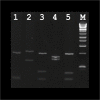Molecular epidemiology of imported cases of leishmaniasis in Australia from 2008 to 2014
- PMID: 25734905
- PMCID: PMC4348169
- DOI: 10.1371/journal.pone.0119212
Molecular epidemiology of imported cases of leishmaniasis in Australia from 2008 to 2014
Abstract
Leishmaniasis is a vector borne disease caused by protozoa of the genus Leishmania. Human leishmaniasis is not endemic in Australia though imported cases are regularly encountered. This study aimed to provide an update on the molecular epidemiology of imported leishmaniasis in Australia. Of a total of 206 biopsies and bone marrow specimens submitted to St Vincent's Hospital Sydney for leishmaniasis diagnosis by PCR, 55 were found to be positive for Leishmania DNA. All PCR products were subjected to restriction fragment length polymorphism analysis for identification of the causative species. Five Leishmania species/species complexes were identified with Leishmania tropica being the most common (30/55). Travel or prior residence in a Leishmania endemic region was the most common route of acquisition with ~47% of patients having lived in or travelled to Afghanistan. Cutaneous leishmaniasis was the most common manifestation (94%) with only 3 cases of visceral leishmaniasis and no cases of mucocutaneous leishmaniasis encountered. This report indicates that imported leishmaniasis is becoming increasingly common in Australia due to an increase in global travel and immigration. As such, Australian clinicians must be made aware of this trend and consider leishmaniasis in patients with suspicious symptoms and a history of travel in endemic areas. This study also discusses the recent identification of a unique Leishmania species found in native kangaroos and a potential vector host which could create the opportunity for the establishment of a local transmission cycle within humans.
Conflict of interest statement
Figures

Similar articles
-
Cutaneous leishmaniasis in North-Western Yemen: a clinicoepidemiologic study and Leishmania species identification by polymerase chain reaction-restriction fragment length polymorphism analysis.J Am Acad Dermatol. 2009 Oct;61(4):e15-21. doi: 10.1016/j.jaad.2009.04.047. Epub 2009 Aug 19. J Am Acad Dermatol. 2009. PMID: 19695737
-
Clinical manifestations and genetic variation of Leishmania infantum and Leishmania tropica in Southern Turkey.Exp Parasitol. 2015 Jul;154:67-74. doi: 10.1016/j.exppara.2015.04.014. Epub 2015 Apr 22. Exp Parasitol. 2015. PMID: 25913665
-
Localized cutaneous leishmaniasis due to Leishmania donovani and Leishmania tropica: preliminary findings of the study of 161 new cases from a new endemic focus in himachal pradesh, India.Am J Trop Med Hyg. 2005 Jun;72(6):819-24. Am J Trop Med Hyg. 2005. PMID: 15964970
-
The potential of using recombinant DNA species-specific probes for the identification of tropical Leishmania.Parasitology. 1986;92 Suppl:S139-74. doi: 10.1017/s0031182000085747. Parasitology. 1986. PMID: 3012443 Review. No abstract available.
-
New World and Old World Leishmania Infections: A Practical Review.Dermatol Clin. 2015 Jul;33(3):579-93. doi: 10.1016/j.det.2015.03.018. Dermatol Clin. 2015. PMID: 26143433 Review.
Cited by
-
Semi-Quantitative, Duplexed qPCR Assay for the Detection of Leishmania spp. Using Bisulphite Conversion Technology.Trop Med Infect Dis. 2019 Nov 1;4(4):135. doi: 10.3390/tropicalmed4040135. Trop Med Infect Dis. 2019. PMID: 31683788 Free PMC article.
-
Imported leishmaniasis cases in Cuba (2006-2016): what have we learned.Trop Dis Travel Med Vaccines. 2018 Aug 7;4:7. doi: 10.1186/s40794-018-0067-3. eCollection 2018. Trop Dis Travel Med Vaccines. 2018. PMID: 30094054 Free PMC article.
-
Imported cutaneous leishmaniasis: a 13-year experience of a Polish tertiary center.Postepy Dermatol Alergol. 2019 Feb;36(1):104-111. doi: 10.5114/ada.2019.82830. Epub 2019 Feb 22. Postepy Dermatol Alergol. 2019. PMID: 30858788 Free PMC article.
-
Laboratory diagnostics for human Leishmania infections: a polymerase chain reaction-focussed review of detection and identification methods.Parasit Vectors. 2022 Nov 5;15(1):412. doi: 10.1186/s13071-022-05524-z. Parasit Vectors. 2022. PMID: 36335408 Free PMC article. Review.
-
Infectious Disease Transmission in Solid Organ Transplantation: Donor Evaluation, Recipient Risk, and Outcomes of Transmission.Transplant Direct. 2018 Dec 20;5(1):e416. doi: 10.1097/TXD.0000000000000852. eCollection 2019 Jan. Transplant Direct. 2018. PMID: 30656214 Free PMC article.
References
-
- Herwaldt BL (1999) Leishmaniasis. Lancet 354: 1191–1199. - PubMed
-
- Alvar J, Yactayo S, Bern C (2006) Leishmaniasis and poverty. Trends Parasitol 22: 552–557. - PubMed
-
- Bart A, van Thiel PP, de Vries HJ, Hodiamont CJ, Van Gool T (2013) Imported leishmaniasis in the Netherlands from 2005 to 2012: epidemiology, diagnostic techniques and sequence-based species typing from 195 patients. Euro Surveill 18: 20544 - PubMed
Publication types
MeSH terms
Substances
LinkOut - more resources
Full Text Sources
Other Literature Sources
Research Materials

